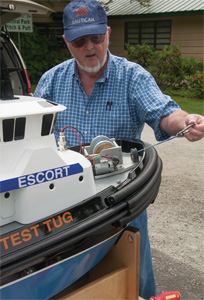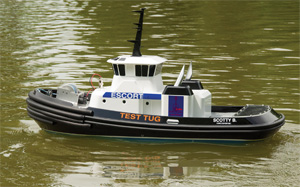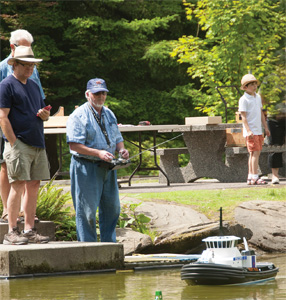In tanks at maritime trade shows from Hamburg to New Orleans, or the pilot training pond at Port Revel, France, or in a little lake at Central Park in Burnaby, British Columbia, the remarkable models of Ron Burchett do much more than entertain. On a recent summer Sunday, Burchett loaded his 1:24-scale model out of the back of a family van parked beside the little Burnaby lake near his North Vancouver home and checked it over for damage from the flight back from Hamburg, where he had attended the International Tug, Salvage & OSV Convention.
These sophisticated vessels provide scale representation of the real tug, not only in appearance but also in performance and handling. This model was the third of three that he recently completed.
“I built these three on a Jensen hull (like the recently delivered Buckley McAllister) for the Massachusetts Maritime Academy,” he explained. “Because that is the same hull used in a lot of East Coast ports.”
Two of the models are precise replicas of the East Coast tugs, but this third one has a modified and extended skeg for Burchett to test some escort design ideas. Burchett grew up in Tofino, a small town on the west coast of Vancouver Island. “I spent a lot of time around the local shipyard sweeping up and carving hulls from wood scraps,” he recalled. “I would put a string on them and watch how they worked in the tidal current off the end of the dock.”
 |
|
Burchett demonstrates the experimental JonRie rotating hawser winch. |
This led to a lifelong fascination with hull forms. Along the way he picked up a master’s ticket and helped design the BRAtt training tug now owned by Harley Marine. (BRA stands for Burchett, Robert Allan). Major naval architects, propulsion suppliers and owners of ship-handling tugs regularly share their technical designs and order model data from Burchett. The model that he was putting into the Burnaby lake was named Scotty B. for his son and carried the designations Escort and Test Tug. It had JonRie winch logos on its stacks.
Other modelers admired each other’s replicas of classic wooden tugs and barges; they stopped to check on the work of the master modeler. Peter Brown and Peter Nicol of Stability Solutions Inc. accompanied Burchett to the lake that day. They had brought along one of their Stabilis devices to install on the model. Burchett is interested in the potential for integrating the device with JonRie winches for installation on ship-handling, escort and even towing tugs.
As a Canadian mariner, Burchett is familiar with the Canadian regulation requiring abort switches on the winches of all Canadian tugs. He is familiar with the history of this proactive regulation. In the postwar decades most tugs were still big heavy wood and steel vessels with power typically in the 700 to 1,000-hp range. Many or even most of these engines were heavy medium-speed machines. On the west coast of Canada, as the smaller but equally powerful high-speed diesels gained popularity, a class of tugs known as “Hot Rods” was developed.
Where the older boats such as the Miki tugs were in the 120-foot range, these new tugs, with equal horsepower, were in the 75-foot range. Some incidents occurred where big heavy barges overtook a tug that lost power or was maneuvering. The result would be that the barge overpowered the tug and dragged it over before the crew could release the brake on the winch. In at least one instance, a barge sank in the Gulf of Georgia and began to pull the tug under. When the deck hand rushed back on deck to release the brake, the winch was already underwater.
As a result of these accidents the Canadian government wisely mandated that all tugs be fitted with abort winches that would allow the operator to release the winch drum from the wheelhouse, to allow the towline to freewheel out. This is now standard equipment on all Canadian tugs and a good number of recently built U.S. tugs.
With the development of ever more powerful escort and ship-handling tugs since the Oil Pollution Act of 1990, the benefits of an abort system have become even more pronounced. So has the speed with which a situation can go bad.
 |
|
The port side of Burchett’s test model Scotty B. in a lake at Burnaby, British Columbia. The stability experiments may lead to a better understanding of when automatic abort would be needed. |
The Stabilis system can be set to automatically release a winch brake at a predetermined angle of heel. The device is designed to serve as a “black box” for a vessel recording details, not only of heel and trim but all aspects of a vessel’s location and performance. It combines the functions of GPS and AIS with the recording and display of a wide range of information on a continuously updating computer that can be read remotely through satellite uplink.
Small enough to be mounted aboard Burchett’s model, it can transmit data to any personal computer or smartphone. But first it must be programmed with all of the vessel’s parameters. That was the purpose of the tug Scotty B.’s performance in the little lake this past June. The men from Stability Solutions recorded all of the vessel’s data under normal operating conditions. These can then be programmed into the device.
Burchett is interested in the potential, then, for integrating this with the hawser winch so that they can add a command for an automatic abort in a predetermined situation. His obsession with tug safety and efficiency doesn’t stop there. He is working with JonRie to develop an electronic backup to the abort switch so that if an escort tug were to suffer a blackout during an operation, a separate and independent 24-volt system would provide the necessary power to release the brake.
For that young boy who was fascinated with hull design and workboats, there was and continues to be no end to improvement projects to be developed in both fields. As the 110-pound, 50-by-20-inch, 1:24 model was lifted from the water to its cradle, Burchett showed the fully-functional rotating hawser winch that he has installed on the bow of Scotty B.
“This will provide a continuous bollard pull right around the 220° of the bow. On tugs like the new Rob Allan boats with the more rounded bow, this will provide excellent fender contact on a ship hull, and on escort work the consistency of the pull will make for safer operation,” he explained with the same delight as that kid back on the dock in Tofino.

